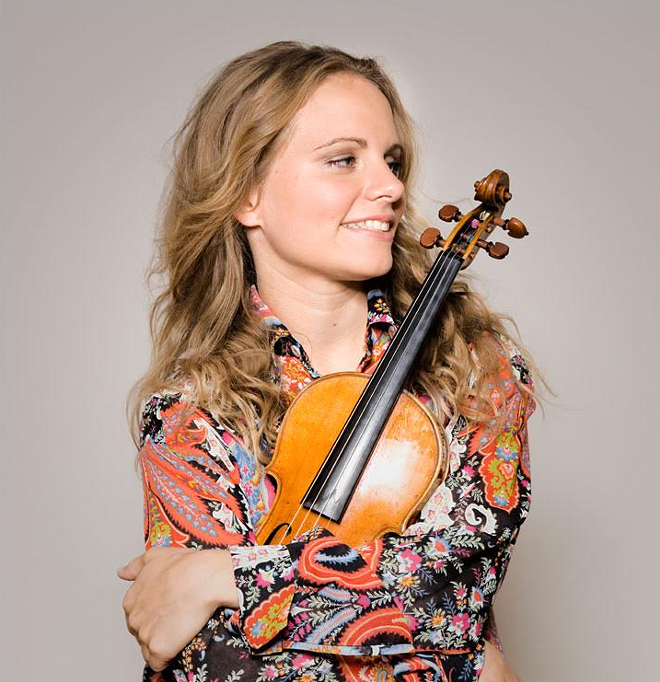Violin Superstar Julia Fischer Performs Rarely Heard Concerto This Weekend With the Cleveland Orchestra
As she prepares for a morning rehearsal with the Cleveland Orchestra, Julia Fischer describes a recurring scene in the life of a touring violin superstar:
“Somebody comes backstage after concerts, somebody I’ve never seen in my life, and they just say, ‘I found this fantastic score in my grandfather’s attic. Can you please have a look?’”
That’s how Fischer came across a rarely heard violin concerto by German composer Hans Werner Henze called “Il Vitalino Raddoppiato.”
“Very often people give me scores, or send me scores at home, or to the Academy of Music in Munich,” she said. “I just carry them all home, and every other month I have a look at what’s lying there.”
Fischer was gifted the Henze score by a fan after a 2006 concert in Frankfurt. In 2012, the year Henze died, Fischer decided to look through the score.
“I opened the first page and I thought, ‘Oh, I know this!’”
Fischer knew the piece because, in a way, she had played it before.
The “Vitalino” in the concerto’s title is a pet name for Italian Baroque composer Tomaso Vitali. Just about every violinist, including Fischer, had to play Vitali’s famous “Chaconne in G minor” when they were growing up.
Vitali’s “Chaconne” inspired Henze to write his own version roughly 300 years later.
A chaconne, at its most basic, is a theme followed by a set of variations, all over a repeating bass line. Henze’s “Raddoppiato” literally “re-doubles” Vitali’s original work by inserting new variations, like panels in a drop-leaf table, between the old ones.
“The first variations are written in the same style as Vitali. You hardly notice,” Fischer said. “And then, during the piece, he gets more and more modern.”
Henze’s modern flourishes include wildly disjunct lines thrown across several instruments, and simultaneous melodies in seemingly different keys. The music becomes so dense at one point that Henze specifies which line should be the most important.
But even Vitali’s original chaconne includes some puzzling features like sudden key changes from one variation to another.
“There are some variations that really don’t go with his time,” Fischer said. “The octaves in the end that he wrote, and also some of the key changes, are very Romantic.”
Vitali almost certainly wrote the G minor theme that opens the chaconne. But some people speculate the variations on the theme were written later, by a violinist named Ferdinand David. David is probably best known for premiering Felix Mendelssohn’s violin concerto in 1845. (Coincidentally—or not—Mendelssohn’s incidental music for “A Midsummer Night’s Dream” will star opposite Henze’s Vitali-inspired concerto this weekend.)
Much of Vitali’s original chaconne remains intact in Henze’s version. I asked Fischer if the Henze is any harder to play.
“Yes!” she said, without missing a beat. “Far more difficult. There’s just no comparison.”
“There are a few variations that are horrible to play,” said Fischer. “There’s one variation that actually needs some changes, because it can’t be played [as written].”
“Il Vitalino” starts simply enough, with the soloist playing Vitali’s theme verbatim, accompanied by a harp.
“In the beginning, it doesn’t sound so difficult. But the variations that Henze wrote as an answer to the ones by Vitali have a lot of string changes,” Fischer explained. “I’m up on the E string and then down on the G string, and again up on the E string. So I have to jump a lot in my hands.”
At one point, Henze went a little overboard.
“Near the end, he wrote a few chords with more than four notes. And because the violin only has four strings, it’s kind of hard to do that!” said Fischer.
To make matters worse, there aren’t many chances for the violinist to recover physically. The soloist plays continuously through most of the piece.
“That’s the problem of a chaconne. When you play a chaconne or a passacaglia, you never get a chance to relax,” said Fischer. “That’s just how it is, because it always continues. There’s no musical break.”
Like running a marathon, pacing is key, if not only for the soloist’s own survival.
“It’s super important that when you start the piece, you know exactly where you want to go,” Fischer said. “If you compare it with any other chaconne, it’s, like, twice as long as the Bach ‘Chaconne’ or the second movement of the Shostakovich first violin concerto, or the last movement of Britten’s violin concerto.”
Fischer said it’s probably the most difficult piece she’s ever learned. But she loves it.
“I’m completely taken by this piece,” she said.
Put simply, “Il Vitalino” is a tour through centuries of musical history. It carries Vitali’s original tune from the Baroque through the Classical and Romantic periods and, finally, the 20th century, when it’s very nearly forgotten.
“The entire piece is 6/4 bars, and then there’s this period of 4/4 bars that’s completely Henze,” said Fischer. “There’s nothing of Vitali left.”
Henze poignantly quotes Vitali one last time at the end of the concerto. “But,” as Fischer put it, “it’s only like a memory.”
“I think that, in the end, Henze arrives in his own music.”
Fischer will perform Henze’s “Il Vitalino Raddoppiato” with the Cleveland Orchestra on May 11, 13 and 14 at Severance Hall.


